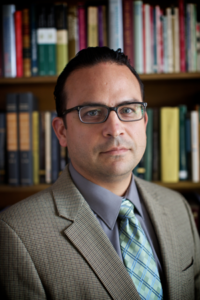
Privileging US Immigration in Biblical Exegesis Courses
The social justice issue that I have consistently raised in my biblical exegesis courses has been US immigration. As I tell my students—mostly white middle-class Protestants fixed on parish ministry—engaging this topic in a sermon will likely incite some criticism from parishioners or even set in motion a premature resignation.
Despite my school’s borderlands location and the exilic content of the Hebrew Bible, pivoting to the topic of US immigration in a biblical exegesis course cannot be done haphazardly. In terms of texts, I find that Genesis (12–50), Exodus, Psalms 120–134, Second Isaiah (40–55) and Lamentations are especially apt for engaging this complex sociopolitical topic. What is unavoidable in these texts are stories about people on the move because of famine, jealousy, conquest, or faith—to name just a few. Yet still, connecting these biblical stories to the lived experiences of migrants in places like the US-Mexico border is by no means a linear process.
No matter how convinced I am that Abram’s journey from the Ur of the Chaldeans to the land of Canaan (Gen 11:31) is a migration story, in order to bring my students along I must confront the assumptions that inform their understanding of migration. A common assumption they often have about migration and by extension immigration is that both phenomena represent a social problem or challenge. At the source of this assumption is indeed not an ancient notion of migration but rather their nation-state formation. By contextualizing the latter, students discover that the problems most associated with migration and immigration in US dominant society—like border crossers as “illegal,” economic strains, cultural threats, and spreaders of disease—stem from Western nationalist forms of inclusion and exclusion. After discovering their own nation-state biases about immigrants, I find it easier to shift to the theme of migration in the biblical text, contrasting along the way the ancient assumptions that likely informed it.
As opposed to nationalist thinking, the biblical text often starts with the assumption that humans are free to move and that this movement constitutes an act of faith rather than a crime. Emphasizing the freedom of movement and the faith that accompanies it in the biblical text, I then pivot to US immigration and the sociopolitical injustices produced by the nation-state’s control of human mobility. Though migration studies, forced migration studies, and refugee studies are useful resources, their approach to immigration is often based entirely on the modern concept of the nation-state and hence tend to view borders, citizenship, and state sovereignty not as human constructs but as natural to our earthly existence. This nationalist-centric agenda can also be transferred unwittingly over to the biblical commentary material that relies on the social sciences. For this reason, I supplement my immigration bibliography with migrant artwork (See https://artedelagrimas.org/), particularly the kind that emphasizes the freedom of movement and faith as in the drawing below:

Dayana, “Mi Jornada (My Journey),” colored pencil and marker, 2014, 9 x 12, Arte de Lágrimas Gallery.
Dayana is from Guatemala and was 7-years old when she drew this art piece about her asylum-seeking journey to the US. She and her mother travelled by car and then by bus. She remembered that the road was long and gray (left side). Her picture narrative ends with them crossing the Rio Grande on a makeshift raft (lancha). She first drew the rocks (piedras) in the river and then the river banks. Next, she drew the makeshift raft in the middle of the river with her and her mother inside it. I asked, “Did anyone say good bye to you?” She replied, “My aunt.” She placed her aunt on the Mexican side of the river waving goodbye. I then asked, “Was there anyone else?” Not saying anything, she removed the rosary from around her neck and traced the plastic crucifix over the Rio Grande. She then began to sing the hymn “En la Cruz, en la Cruz, yo primero vi la luz, y las manchas de mi alma yo lavé, fue allí por fe yo vi a Jesús, y siempre feliz con El seré (At the Cross).” Her and her mother sang these words while on the raft. In the drawing the cross is the symbol of faith that accompanied Dayana’s migratory movement across the Rio Grande—the symbol of a territorially bounded state. Like Abram’s story, her faith assumes the freedom of movement.
Leave a Reply